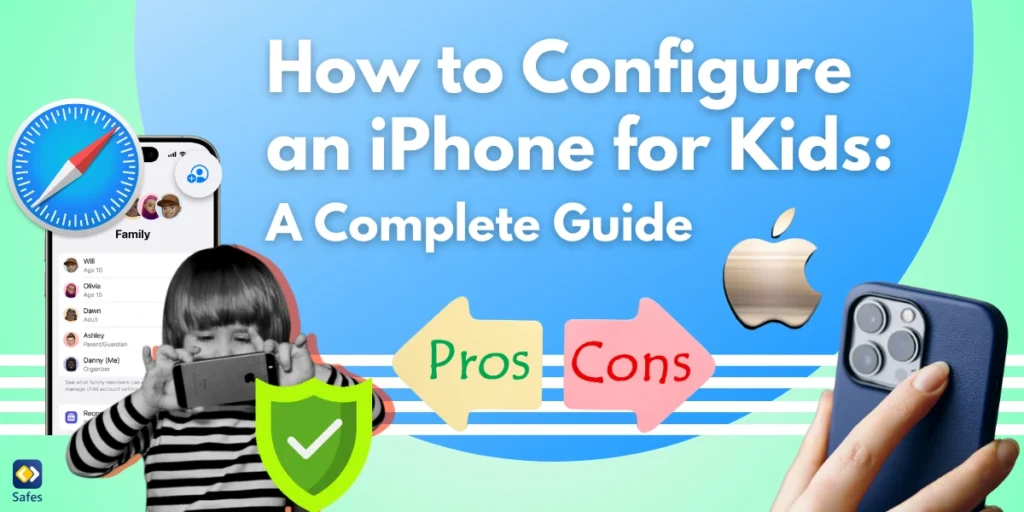In today’s world, it can be difficult for students to put their phones down and focus on their studies. Smartphones and other devices have become so pervasive that it can be hard for teenagers to resist the temptation of scrolling through their social media or checking their notifications. If left unchecked, phone addiction can be detrimental to a student’s academic performance, as well as their physical and mental health. Therefore, it’s crucial to know how to stop phone addiction for students.
Download and Start Your Free Trial of the Safes Parental Control App
Reasons Why Students Develop Phone Addiction
Parents and teachers need to understand why students develop phone addiction. This will help them to understand teenagers better, in order to help them deal with their addiction. Here are a few reasons why students may be drawn to their phones:
- Feeling the need to stay connected to friends and family
- They feel the desire to be part of the latest trends and have the fear of missing out (FOMO)
- They feel the need to escape from reality
- They enjoy the challenge of multitasking

Signs of Smartphone Addiction
To be able to help your teenager and know how to deal with teenage phone addiction, it can be helpful to know what some of the possible signs are:
- Completing daily tasks become more difficult
- Your teenager is isolating themselves from family and friends
- They want to hide their smartphone use and get upset when you mention their phone habits
- They feel dread, anxiety, or panic when leaving their phone at home
Strategies for Parents and Teachers
Once you have established that your child has a phone addiction and you understand why they might be addicted to their phones, you can start to build strategies to help them. Let’s go over a few tips for how to stop teenage phone addiction:
Setting Boundaries and Expectations
Establishing clear rules and expectations for phone usage in the classroom and at home can help students become aware of their phone addiction. For example, you could set one hour for a task and a 10-minute break to use their phone. This could help them grasp the concept better of how useful an hour can be. They will also become more aware of their possible addiction when it is hard for them to put away their phone after the break. Moreover, they will enjoy the well-deserved break more.
Encouraging Other Activities
Encourage students to find activities that are unrelated to their phones. This could include outdoor activities, sports, artistic activities, etc. This will cause them to experience the joy of missing out (JOMO) instead of fear of missing out (FOMO). This means that through having meaningful and rewarding activities, they learn that life can be fulfilling when they aren’t constantly updated about the life of others. Developing new offline habits can feel liberating. Even though phone-addicted children seem to be enjoying their time on the phone, it’s almost always a passive mind-dulling activity. In other words, teenagers keep using their phones long after they have felt the need to put them away. So, encourage them to do other things, and it is guaranteed that they will feel better. Even if it seems challenging at first.
Modeling Healthy Habits
Parents and teachers should lead by example and avoid using their phones during class or family time. When you set the right example, your student or teenager tends to adopt your habits. When others are distracted and busy with their phones, it can become discouraging for teenagers to spend time with loved ones. Having eye-to-eye and engaging conversations can encourage your children to put away their phones.

Using Parental Controls
Parents can use parental controls to limit the amount of time their children can spend on their devices. With parental controls, it is possible to monitor and control your child’s internet and social media use. One of the best parental control apps is Safes. Safes offers a lot of features like:
- Screen time schedule: This feature protects children from excessive and harmful screen time and distractions.
- Instant block: You can block your child’s phone completely, to prevent them from using it and make them more present in the moment.
- Website content filtering: This feature blocks out inappropriate websites. Parents can also select specific content categories or add some exceptions to block or exclude.
Safes’ free app is available to download for Android, iOS, and even desktop versions for Windows and MacOS.
Conclusion
By following these tips, parents and teachers can help students break their phone addiction and reap the benefits of gaining control of their phone usage. Students will be able to focus more on their studies, increase their physical activity, and build healthier mental habits.
Your Child’s Online Safety Starts Here
Every parent today needs a solution to manage screen time and keep their child safe online.
Without the right tools, digital risks and excessive screen time can impact children's well-being. Safes helps parents set healthy boundaries, monitor activity, and protect kids from online dangers—all with an easy-to-use app.
Take control of your child’s digital world. Learn more about Safes or download the app to start your free trial today!




